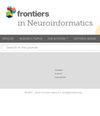ExaFlexHH: an exascale-ready, flexible multi-FPGA library for biologically plausible brain simulations
IF 2.5
4区 医学
Q2 MATHEMATICAL & COMPUTATIONAL BIOLOGY
引用次数: 0
Abstract
IntroductionExaFlexHH:可用于生物仿真大脑模拟的外显子就绪灵活多 FPGA 库
导言:在现代神经科学中,硅学仿真是一种强大的工具,可以增强我们对不同生理水平的复杂大脑系统的理解。要建立逼真细致的生物系统模型,理想的仿真平台必须具备:(1) 高性能和性能可扩展性;(2) 灵活性;(3) 易于非技术用户使用。然而,现有的大多数平台和库并不符合这三个标准,尤其是对于霍奇金-赫胥黎(HH)模型等复杂模型或间隙连接等复杂神经元连接建模。ExaFlexHH 利用基于 FPGA 的数据流引擎 (DFE) 和数据流编程范例,满足了所有三个要求。该库还可参数化,并与计算神经科学领域著名的大脑描述语言 NeuroML 兼容。我们利用 ExaFlexHH 实现了一个高要求的下橄榄体扩展霍奇金-赫胥黎(eHH)模型,证明了该平台的性能可扩展性。结果模型模拟结果显示,对于无连接的网络具有线性可扩展性,而对于具有复杂突触可塑性的网络则具有接近线性的可扩展性。值得注意的是,我们的研究结果还显示了一致的每瓦 GFLOPS 性能效率,进一步提高了可用于外设的计算速度,并推动了未来大脑仿真平台的发展。
本文章由计算机程序翻译,如有差异,请以英文原文为准。
求助全文
约1分钟内获得全文
求助全文
来源期刊

Frontiers in Neuroinformatics
MATHEMATICAL & COMPUTATIONAL BIOLOGY-NEUROSCIENCES
CiteScore
4.80
自引率
5.70%
发文量
132
审稿时长
14 weeks
期刊介绍:
Frontiers in Neuroinformatics publishes rigorously peer-reviewed research on the development and implementation of numerical/computational models and analytical tools used to share, integrate and analyze experimental data and advance theories of the nervous system functions. Specialty Chief Editors Jan G. Bjaalie at the University of Oslo and Sean L. Hill at the École Polytechnique Fédérale de Lausanne are supported by an outstanding Editorial Board of international experts. This multidisciplinary open-access journal is at the forefront of disseminating and communicating scientific knowledge and impactful discoveries to researchers, academics and the public worldwide.
Neuroscience is being propelled into the information age as the volume of information explodes, demanding organization and synthesis. Novel synthesis approaches are opening up a new dimension for the exploration of the components of brain elements and systems and the vast number of variables that underlie their functions. Neural data is highly heterogeneous with complex inter-relations across multiple levels, driving the need for innovative organizing and synthesizing approaches from genes to cognition, and covering a range of species and disease states.
Frontiers in Neuroinformatics therefore welcomes submissions on existing neuroscience databases, development of data and knowledge bases for all levels of neuroscience, applications and technologies that can facilitate data sharing (interoperability, formats, terminologies, and ontologies), and novel tools for data acquisition, analyses, visualization, and dissemination of nervous system data. Our journal welcomes submissions on new tools (software and hardware) that support brain modeling, and the merging of neuroscience databases with brain models used for simulation and visualization.
 求助内容:
求助内容: 应助结果提醒方式:
应助结果提醒方式:


